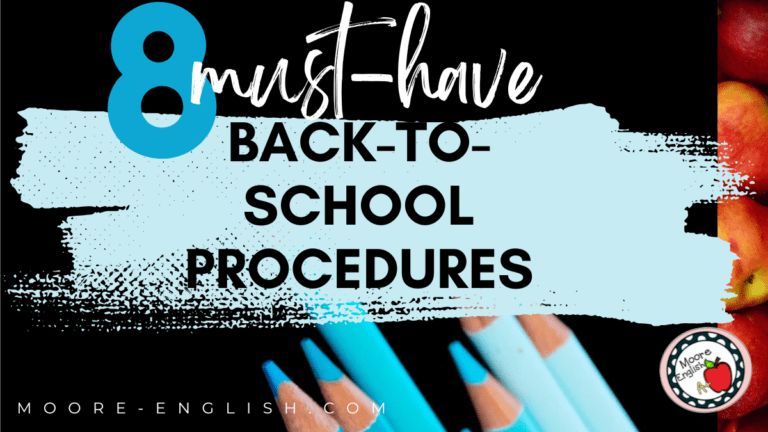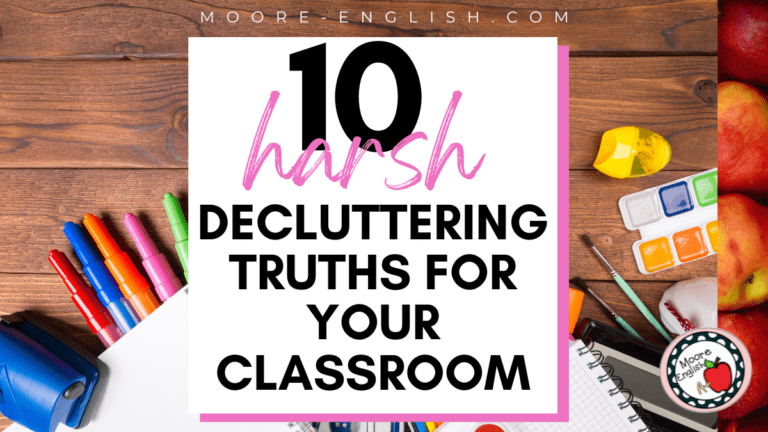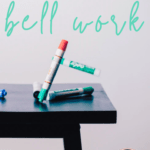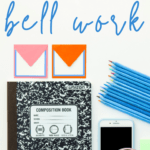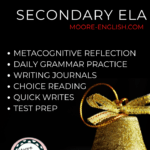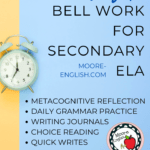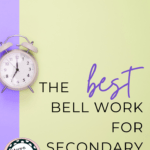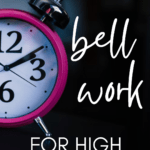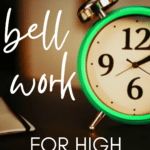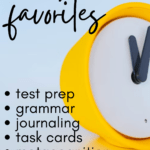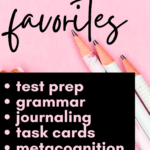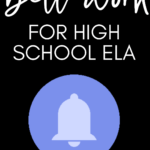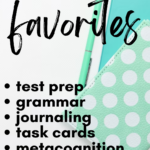I am a believer in classroom procedures and routines. Bell work is one of the most important routines in my classroom.
Here are 5 reasons to include bell work:
- Bell work helps ensure that every minute of class time is used well.
- Routines make students feel comfortable because you are prepared for them.
- Giving students bell work provides focus and limits opportunities for chicanery.
- While students finish bell work, teachers can handle quick tasks like attendance.
- Most importantly, this signals to students that you value their time, and you don’t want to miss a moment of learning.
Over the years, I have tried a variety of bell work systems and strategies. While the task varies based on the students, class, and time of the year, the routine stays the same. I greet students in the hallway during passing period, they come in and read the board, and then they get started. Today, I want to share how I organize bell work and my favorite types of bell work.
This post this post may contain affiliate links. Please read the Terms of Use.
How to Organize Bell Work
I spend some time at the start of the school year getting bell work lined out for the year. You might wonder: how can you plan for an entire year when you haven’t met your students? Regardless of the students that enter my room, I know where I want students to end the year. This goal comes from my district’s curriculum.
Furthermore, based on previous experience, I have a pretty good idea of where students will be when they enter my classroom. Nevertheless, as I get to know my students, I will adjust the plan along the way: adding or subtracting a skill or concept as needed.
Then, I decide on a delivery system. Because of the pandemic, I did 100% digital bell work this year, building everything in Google Slides and Google Classroom. This was helpful because students could switch back and forth between in-person and distance learning with little struggle. Everything was always in the same place. Similarly, students rarely lost their work. However, I did notice that students retained less information than I would usually expect.
For this reason, I will be returning to paper bell work as soon as it is safe to do so. In the past, I began the year by giving students a class binder. Depending on the class, we add the new set of bell work every week or every other week. While students receive the bell work on a schedule, I have everything pretty well planned out ahead of time, so I’m not always in a state of content creation.
With paper bell work, I do occasionally have students lose their work. However, this is mitigated by sharing the digital copy on Google Classroom. Most importantly, my students retain more information from bell work when we use paper.
My Favorite Bell Work Option: Grammar Practice
Overwhelmingly, my favorite bell work is grammar. While not every English teacher loves teaching grammar, I adore teaching grammar. My students are getting ready to take the ACT, and the English section of the ACT is the easiest place to pick up points. While a standardized test cannot drive all instruction, my students regularly come back to thank me for helping them prepare for this assessment.
Some of my favorite grammar activities include:
- Pronoun Card Sort
- The Parallelism Game
- Ted-ed Grammar Videos
- Free Paragraph Card Sort
- Grammar and Vocabulary Fun Bundle
Building Readers Through Choice Reading
Once or twice a week, I try to provide students with silent reading time as bell work. (In the interest of full disclosure, this is something I’ve really struggled with this year. All the instruction lost to sanitizing has come from choice reading time.) Choice reading is a great way to help students discover their love of reading. Depending on the group of students, I use independent reading time to model reading, to complete comprehension interviews, and/or to lead a small reading group.
My students love choice reading time! This is an easy way to build a community of readers and to emphasize the joy of reading. Some of my favorite resources to use with independent reading time include:
- Task Cards
- Book Cover Design
- Characterization Printables
- First Impressions Book Reviews
- Plot, Conflict, and Setting Printables
Writing as Bell Work
Additionally, bell work is also a great way to get students writing every single day. Especially when we are in a novel unit, this can help students make connections with the text, can help teachers monitor comprehension, and can be a starting place for classroom conversations. I have several sets of journal prompts ready to go for my favorite novel studies. Usually, I write journals alongside students, and each student is asked to share one journal per week.
Similarly, Quick Writes are also make great option. With my freshmen, I use visual writing prompts that help them practice making inferences. This is a great strategy to use with groups of reluctant writers or with students that struggle to simply begin writing. My favorite visual prompts are here:
- People and Faces: Visual Writing Prompts Vol. 1
- Places and Objects Visual Writing Prompts Vol. 2
- Popular Culture: Visual Writing Prompts Vol. 3
- Free Visual Writing Prompts Sampler
Metacognitive Morning Work
Over the years, reflection has become an increasingly important part of my classroom. In the past, I’ve written about the importance of inviting metacognition into the classroom.
Because bell work is usually pretty short, it can be a fantastic opportunity to invite metacognition and reflection. In this way, students can frame their thinking for the day, week, or unit to come.
Students can use metacognitive bellwork to set goals, reflect on their goals, and/or provide feedback on their learning process.
Here are some of my favorite tools for promoting metacognitive thinking:
- Classroom Bucket Lists
- ELA Goal Setting Freebie
- Timed Writing Data Sheets
- Grammar and Writing Data Sheets
A Test Prep Opportunity
In May, my sophomores took our state End-of-Course exam. (Yes, you’re right–it is absurd that we are giving a standardized test in a pandemic. I would love to talk about this someday, but this is not that post.) Knowing that students would be taking this test, I devoted a week of bell work to test prep.
While I have many opinions on standardized testing, I really wanted me students to feel prepared for this test. I didn’t want to raise their anxiety but to lower their anxiety by helping them know what to expect and by helping them realize how much they know. The bottom line is that they have grown so much this year. This helped them see that growth, and it makes me certain that they well on their tests.
What is your favorite way to use bell work?

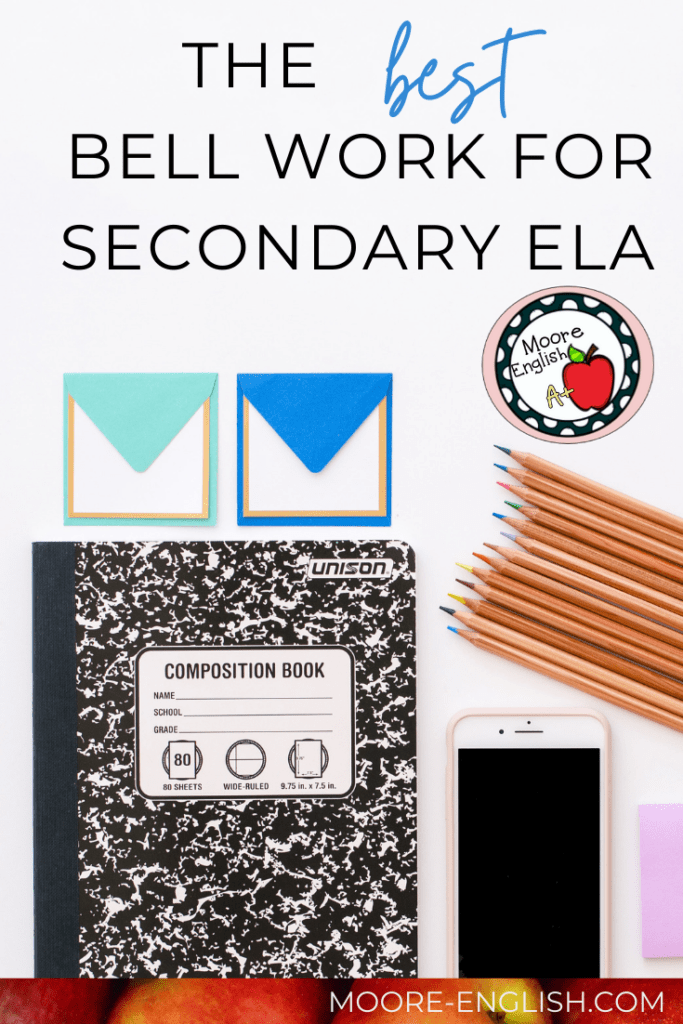
Photo Credits: Speaking of Images and Coffee Beans and Children’s Dreams




